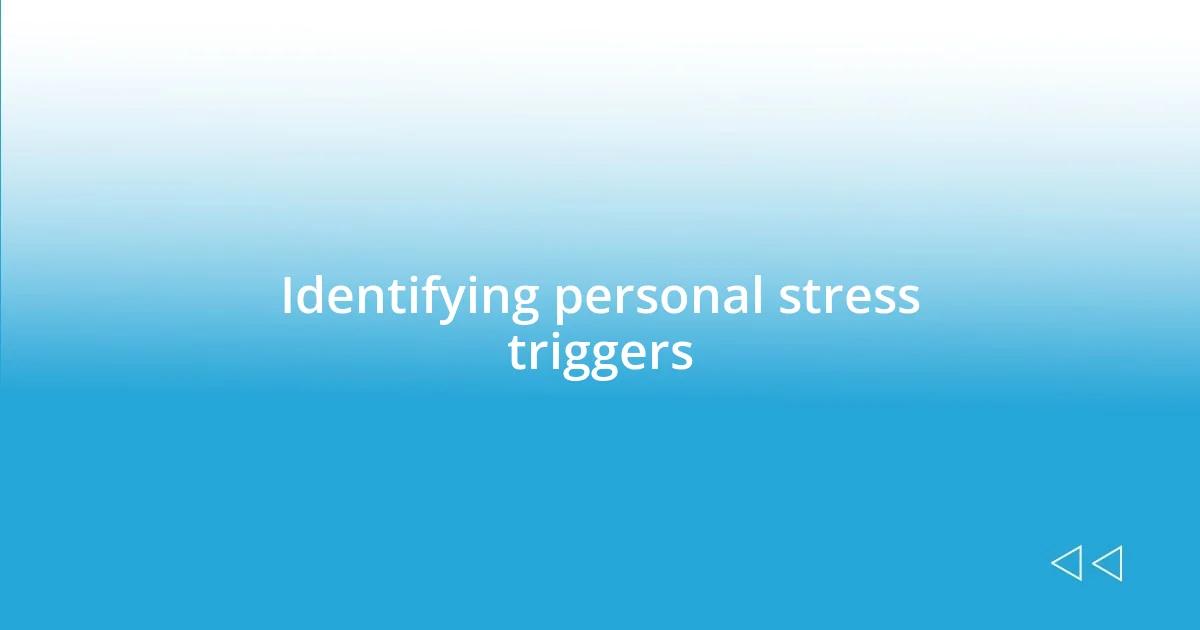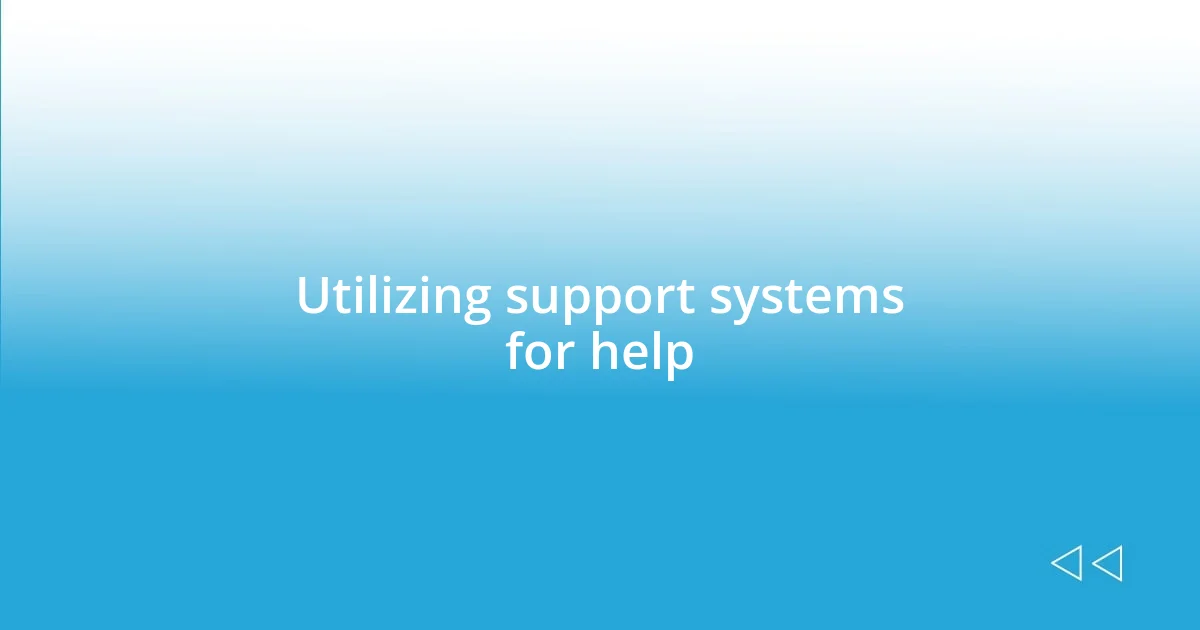Key takeaways:
- Recognizing and identifying personal stress triggers, such as traffic delays and social situations, is essential for effective stress management.
- Incorporating breathing techniques, mindfulness practices, and physical exercises can significantly reduce stress and improve mental well-being.
- Utilizing support systems, including friends, family, and professional help, enhances resilience and provides a sense of connection during challenging times.

Understanding stress and its impact
Stress is a natural response to the demands placed on us, but its effects can be overwhelming. I remember a time when deadlines seemed to loom over me like dark clouds, affecting my focus and productivity. Have you ever noticed how stress can sap your energy and alter your mood, almost as if a switch was flipped?
The impact of stress goes beyond just feeling anxious; it can seep into our daily lives and relationships. I’ve experienced how easily irritability can slip into conversations, often creating unnecessary tension. It makes me wonder: how often do we pause to recognize the emotional toll that stress takes on those around us, not just ourselves?
The physiological effects of stress can be alarming as well. For instance, I’ve felt that telltale tightening in my chest during particularly stressful moments. It’s fascinating—and a bit frightening—to think that our bodies can showcase symptoms like headaches or fatigue as a cry for help. Have you felt your heart race during a stressful situation? It’s a powerful reminder that our mental state is deeply intertwined with our physical well-being.

Identifying personal stress triggers
Identifying personal stress triggers is a vital step in managing stress effectively. I’ve often found that certain situations provoke my anxiety more than others—like being stuck in traffic when I’m already late. Recognizing these triggers allows me to prepare mentally, which can change how I react when faced with similar situations.
Journaling has been a key tool for me in this process. On days when I felt overwhelming stress, I made it a habit to jot down what I was experiencing. Reflecting on those notes later revealed patterns I wouldn’t have recognized otherwise. For instance, I noticed that social gatherings often drained my energy, which is intriguing since I love being around friends.
Sometimes, I also encourage myself to ask, “What situations do I dread?” This question helps me reflect on past experiences that caused significant stress, leading to a clearer picture of my stressors. Distilling these moments into a manageable list fosters a sense of control—like I’ve taken a little piece of my stress back for myself.
| Stress Trigger | Personal Reflection |
|---|---|
| Traffic Delays | Heightens my anxiety and frustration, especially when I’m already running late. |
| Large Social Events | Rather than enjoying them, I often feel drained and overwhelmed. |
| Work Deadlines | Reminds me of the pressure I put on myself, which leads to rushing and mistakes. |

Effective breathing techniques for relaxation
Breathing techniques are a powerful tool for relaxation, and I’ve come to appreciate their profound impact on my stress levels. Whenever I find myself frazzled, focusing on my breath helps ground me in the present moment. I’ve discovered that simply inhaling deeply and exhaling slowly can create a noticeable shift in my mood, almost like a gentle wave washing over my body.
Here are some effective breathing techniques that have worked wonders for me:
-
Diaphragmatic Breathing: This involves breathing deeply from your diaphragm rather than your chest. I place one hand on my belly. When I inhale, I feel it rise, promoting relaxation and reducing tension.
-
4-7-8 Breathing: Inhale for four seconds, hold for seven, and then exhale for eight. I’ve relied on this technique during sleepless nights, and it helps calm my racing mind.
-
Box Breathing: I envision a box and breathe in for four counts, hold for four, exhale for four, and hold again for four. It’s a rhythmic way to regain focus in stressful moments.
Whenever I practice these techniques, I notice a shift not just in my body but in my mind as well. It’s a reminder of how powerful something as simple as breathing can be when we are overwhelmed.

Mindfulness practices for everyday life
Mindfulness can weave its way seamlessly into daily routines, transforming ordinary moments into mindful experiences. When I’m waiting in line or stuck at a red light, I try to engage my senses fully—what do I see, hear, or smell? This simple practice often pulls me out of my busy mind and helps me become present, reminding me just how rich life is in those small moments.
Taking a mindful minute to savor my morning coffee has also made a world of difference for me. Instead of guzzling it down on autopilot, I pause and truly experience the aroma, the warmth of the cup in my hands, and the flavor on my tongue. It sounds trivial, but that little ritual sets a positive tone for my entire day.
I often ask myself, “How can I infuse mindfulness into my chores?” Whether I’m washing dishes or folding laundry, I’ve found that focusing on the task at hand—feeling the water’s warmth or the fabric’s texture—can turn mundane activities into a practice of mindfulness. It’s remarkable how these small shifts can create a calmer, more centered mindset throughout my day.

Physical exercises for stress relief
Engaging in physical exercise has been a game changer for my stress management. Whether I’m hitting the gym for a solid workout or going for a brisk walk, I feel a notable release of pent-up tension in my body. I remember a particularly stressful week at work when I decided to start jogging in the mornings. The rhythmic pounding of my feet on the pavement not only cleared my mind but also filled me with a sense of accomplishment—I could feel my worries fading with each stride.
Incorporating yoga into my routine has brought a deeper layer of relaxation. During those moments on the mat, as I flow through the poses, I can physically feel my stress melting away. Have you ever felt that stretch in your back during a downward dog? It’s a gentle reminder that my body is capable of both strength and surrender. The way yoga encourages mindfulness helps me to reconnect with my breath and find peace, even amidst chaos.
Also, I’ve explored various group classes, like Zumba and kickboxing. The combination of movement, music, and camaraderie creates a joyful atmosphere. I often find myself smiling, laughing, and forgetting about my worries for a while. When the beats drop, I realize it’s more than just exercise—it’s a celebration of life! Have you experienced that liberating feeling of dancing away your stress? It’s a reminder that physical activity doesn’t have to be a chore; it can be a source of joy and connection.

Creating a balanced daily routine
Creating a balanced daily routine requires a thoughtful approach to time management. I’ve found that scheduling my day into dedicated blocks—such as work, exercise, and relaxation—has significantly reduced my stress levels. I often ask myself, “How can I create a flow that feels natural?” Aligning activities with my energy levels has become my secret ingredient; for instance, I tackle complex tasks when I’m most alert and leave more routine activities for when I’m winding down.
Moreover, I incorporate breaks strategically throughout my day. When I first started this practice, I was skeptical—wouldn’t more breaks just cut into my productivity? But I soon realized these moments of pause are essential. I love stepping outside for fresh air; a few minutes in nature can recharge my spirit and clear my mind. It’s refreshing how such simple choices can bring clarity and focus back into my life.
Another vital aspect of my routine is reflection. I’ve embraced the habit of journaling each evening, where I jot down my thoughts and feelings. It’s incredible how a few minutes of reflection can highlight what went well and what I could improve. Have you ever considered how just writing things down can lift a weight off your shoulders? This practice has not only deepened my understanding of my daily experiences but also fostered a sense of gratitude that brightens my perspective.

Utilizing support systems for help
Utilizing support systems has been a lifeline for me during challenging times. I remember a particularly tough period when work pressures piled up; I reached out to a close friend who immediately offered her support. Just talking with her, sharing my worries and getting her perspective, made me feel less isolated. Isn’t it incredible how a simple conversation can lighten the heaviest of burdens?
Family and friends can provide a safety net that cushions those tough falls. I’ve also joined a local support group that focuses on stress management, and it has been eye-opening. Meeting regularly with others who share similar experiences has created a sense of camaraderie. I often think, “How reassuring is it to know we’re not alone in this?” Sharing our stories, laughing at our mishaps, and learning from each other has reinforced the power of collective resilience.
Yet, I’ve found that sometimes professional support is equally important. When I felt overwhelmed, my therapist helped me leverage my support network more effectively. She guided me to articulate my needs clearly with my loved ones, which, surprisingly, improved my relationships. Have you ever realized the strength a little vulnerability can bring? Embracing support systems, whether from friends, family, or professionals, has profoundly shaped my approach to stress management.














